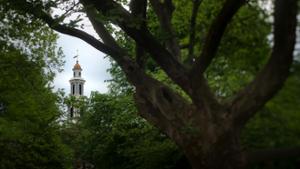
“The Village of Clinton pumps groundwater for its municipal water supply and its pumping fields are located near Oriskany Creek,” Brimmer, a geosciences and environmental studies double major, said. “We hypothesized Clinton was pumping enough groundwater to draw, or induce, water from Oriskany Creek into the aquifer (area of groundwater storage), and we hypothesized stream water was contaminating the groundwater. This has important health and safety implications because pollutants from Oriskany Creek can seep into the municipal groundwater supply.”
Brimmer and Kannan spent the summer of 2022 digging into research alongside Professor of Geosciences and Director of Environmental Studies Todd Rayne, who noted that while work in the field was difficult, “nothing ever fazed” his students, who were eager to do whatever was necessary with smiles on their faces.
“I loved how Maya’s and my thoughts, opinions, and questions were taken as seriously as [Rayne] took his own thoughts and opinions. It created a co-worker dynamic versus a professor and student relationship. I felt as though our thoughts were really valued and mattered.”
“[The field component] involved carrying heavy equipment while wading in fast-moving water with slippery cobbles in Oriskany Creek,” Rayne explained. “They pounded steel pipes into the streambed to install devices to measuring devices and temporary wells, they measured the stream discharge multiple times – a laborious process of measuring stream velocity and depths in multiple points along transects – and they collected lots of water samples from the streams and nearby wells. They were also really good in the lab and became really good at operating the analytical equipment and using GIS, Matlab, and Excel to interpret their results. I was really impressed – and proud – of how well they worked as a team.”
A highlight of the experience for the students was the truly collaborative working environment that Rayne facilitated.
“I loved how Maya’s and my thoughts, opinions, and questions were taken as seriously as [Rayne] took his own thoughts and opinions,” Brimmer said. “It created a co-worker dynamic versus a professor and student relationship. I felt as though our thoughts were really valued and mattered.”
Brimmer, who is working on an extension of this project with Rayne for her senior thesis, explained that the researchers have found that municipal groundwater pumping is inducing, or drawing, water from Oriskany Creek into the aquifer in a short portion of the Creek near the pumping field, and that stream water is contaminating Clinton’s groundwater supply. Further research is needed to learn more about how the pumping-induced drawdown affects Clinton’s water supply. While she doesn’t believe her future plans will involve long-term research projects, Brimmer is grateful for the opportunity that led to her doing impactful work.
Expect Opportunity
Ensuring all students have equal access to all that Hamilton offers is our most enduring value. Receive funding to conduct research, present at a conference, take on an unpaid internship, and more.
“I really enjoy working on this local project with tangible results,” she said.
Funding from Hamilton “made this trip financially sustainable” for Brimmer and Kannan. Parts of the travel expenses for the conference and some of the research equipment used in the field were supported by the Joel W. Johnson Family Professor of Environmental Science endowed professorship, a post which Rayne currently holds. Additional conference and other related costs were covered by the Dean of Faculty Office, Kirkland Endowment Advisory Committee, and the Geosciences Department.
Posted January 5, 2023


